Method and apparatus for dynamically adjusting distributed queing system and data queuing receiver reference voltages
a distributed queing system and data queuing technology, applied in the field of methods and apparatus, can solve the problems of not fitting into the ddr slot, generating a great amount of heat for processors running at higher frequencies, and limited bandwidth of sdram
- Summary
- Abstract
- Description
- Claims
- Application Information
AI Technical Summary
Benefits of technology
Problems solved by technology
Method used
Image
Examples
Embodiment Construction
[0023]One aspect of the exemplary embodiments is a method for an efficient method for automatically setting DQS (Distributed Queuing System) and DQ (Distributed Queuing) receiver reference voltages to an optimal level. In another aspect of the exemplary embodiments a receiver sets its own reference voltage automatically to a level that gives the high and low level of DQS on a memory the same time interval, regardless of DQS rise and fall time because of the large amount of time the DQS receive signal is spent in transition.
[0024]GDDR3 (Graphics Double Data Rate, version 3) DRAM (Dynamic Random Access Memory) data (and DQS) nets are typically terminated to the voltage VDD. Most designers set their receiver reference voltages based on what they think the typical drive strength of the DRAMs is. The problem is that when DRAMs with higher impedance drivers are used, the reference voltage is set to low. Also if the DRAMs have a lower than expected driver impedance, the fixed reference vol...
PUM
 Login to View More
Login to View More Abstract
Description
Claims
Application Information
 Login to View More
Login to View More - R&D
- Intellectual Property
- Life Sciences
- Materials
- Tech Scout
- Unparalleled Data Quality
- Higher Quality Content
- 60% Fewer Hallucinations
Browse by: Latest US Patents, China's latest patents, Technical Efficacy Thesaurus, Application Domain, Technology Topic, Popular Technical Reports.
© 2025 PatSnap. All rights reserved.Legal|Privacy policy|Modern Slavery Act Transparency Statement|Sitemap|About US| Contact US: help@patsnap.com



